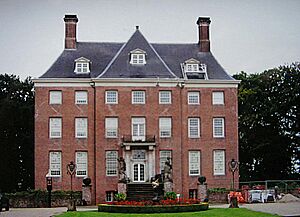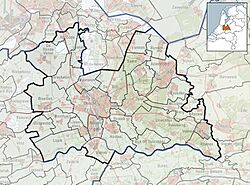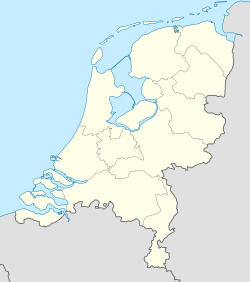Amerongen facts for kids
Quick facts for kids
Amerongen
|
|||
|---|---|---|---|

Amerongen Castle
|
|||
|
|||
| Country | Netherlands | ||
| Province | Utrecht | ||
| Municipality | Utrechtse Heuvelrug | ||
| Area | |||
| • Total | 29.68 km2 (11.46 sq mi) | ||
| Elevation | 42 m (138 ft) | ||
| Population
(2021)
|
|||
| • Total | 6,985 | ||
| • Density | 235.34/km2 (609.54/sq mi) | ||
| Time zone | UTC+1 (CET) | ||
| • Summer (DST) | UTC+2 (CEST) | ||
| Postal code |
3958
|
||
| Dialing code | 0343 | ||
Amerongen (Dutch pronunciation: [ˈaːmərɔŋə(n)]) is a charming town in the Netherlands. It is located in the province of Utrechtse Heuvelrug. The town sits right on the edge of the Utrecht Hill Ridge, a beautiful area with rolling hills. Amerongen is about 7 kilometers (4.3 miles) southwest of Veenendaal.
The land around Amerongen changes from flat, watery meadows near the Nederrijn (Lower Rhine) river to the higher Utrecht Hill Ridge. East of the village, you'll find the Amerongense Berg (Amerongen Mountain). It is 69 meters (226 feet) above sea level. This makes it the highest point in the western Netherlands!
In 2021, about 6,985 people lived in Amerongen. The surnames "Amerongen," "Van Amerongen," and "Van Nieuw Amerongen" mean that someone's ancestors came from this area.
Contents
A Peek into History
Amerongen Castle: A Story of Survival
The history of Amerongen is closely tied to its famous Amerongen Castle. This castle was first built way back in 1286, starting as a wooden tower. Over the years, it was rebuilt in stone. It faced many challenges, including being damaged or destroyed by fire several times.
In 1672, the French army invaded the Netherlands. In early 1673, they even burned down Amerongen Castle! This was a punishment because people had not paid taxes to the French. But the castle was quickly rebuilt. A clever woman named Margaretha Turnor, whose husband owned the castle, oversaw the rebuilding. The new castle was built in the beautiful Dutch Classicist style. Even though the gardens and inside of the castle were updated later, it is still a great example of this style.
A Royal Refuge
After World War I ended in November 1918, the former Emperor of Germany, Wilhelm II, came to the Netherlands seeking safety. He lived in Amerongen Castle until May 1920. It was right there, in the Castle of Amerongen, that he signed the papers to give up his power as Emperor. After that, he moved to nearby Doorn, where he lived for the rest of his life.
Changes in Local Government
Until January 1, 2006, Amerongen was its own separate municipality (like a small local government area). It included the village of Amerongen itself, plus Overberg and part of Elst. Then, Elst became part of the Rhenen municipality. The largest part of Amerongen joined with four other municipalities to form the new Utrechtse Heuvelrug municipality.
Economy and Transportation
Past Industries
Amerongen used to have a big tobacco industry until the 19th century. But this industry declined because people started smoking cigars more. The tobacco grown in Amerongen was not good for cigars. Also, tobacco from other countries became more popular.
In 1879, the local Earl of Amerongen, Aldenburgh Bentinck, tried to help the town's economy. He opened a cream factory in 1890, but it closed in 1912. Then he encouraged villagers to grow tulips. However, the Dutch market for tulips was already very strong, so this plan did not work either. In a final effort, the Earl suggested growing hops (used in making beer), but this plan also failed. Because of these challenges, most villagers had to find jobs in nearby towns.
Today, the factory for Technivorm, which makes the famous Moccamaster coffee machine, is located in Amerongen.
Getting Around
Amerongen is served by one bus line, line 50. This bus goes to Utrecht and also to Veenendaal and Wageningen.
The village also used to have a tram line. It ran from November 9, 1884, until 1949. This tram went from Zeist to Arnhem. At first, steamtrams were used. The tram line became electric in 1922. However, more and more buses started to be used, which led to the tram service stopping in 1949. There are no tram tracks left in the village today.
Gallery
See also
 In Spanish: Amerongen para niños
In Spanish: Amerongen para niños









